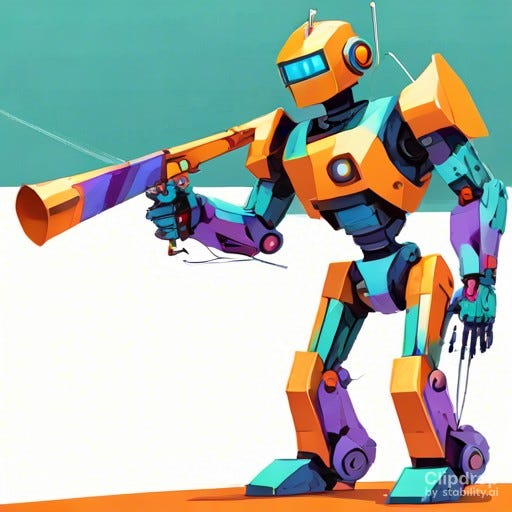MAESTRO: Creating the Substack Newsletter (Part 1)
USING AI TO DESIGN AND DEVELOP A CONSUMER APPLICATION
I settled on Substack for a couple of reasons, popularity, ease of use and discoverability. I’m already active on the platform and I figured it was a great place to start this journey.
For Maestro’s prologue I decided to put the prospective AI tools to the test by creating the branding for a Substack newsletter.
OVERVIEW
THE TECH
Here are the tools that I used for this experiment:
Claude.Ai - ideation, prompt generation
ChatGPT 3.5 - ideation, prompt generation
DALL-E 2 - image generation
Added image gen Feb 2024
Rebranded to Gemini Feb 2024
CoPilot (GPT-4) - ideation, prompt generation
Grok - ideation, prompt generation
Image Creator (DALL-E 3) - image generation
Microsoft Designer - image editing, animation
Stable Diffusion Turbo - image generation
BASE PROMPTS
I used two sessions with the following setup prompts:
SALES AND MARKETING GURU
I want you to act as a sales and marketing guru. I will ask you a
question. You will provide answers and explain how you arrived
at the solution.AI IMAGE GENERATION PROMPT
I want you to act as an expert machine learning model trainer. I will
provide a description of an object, person, or idea. You will provide
an efficient and optimized AI prompt to generate an image of the
item I describe.
I wanted to generate a square logo that I could use to identify the project and I needed something that both captured the intention of the project but would also be iconic when scaled down.
I started the following request prompt:
Give me ideas for a brand logo for a Substack newsletter about using
AI to design and develop a consumer application.LOGO
STRATEGY
Stack multiple AI technologies in three phases:
Theme Creation - Brainstorm themes using large language models
Prompt Optimization - Use LLM to build efficient text-to-image prompts
Image Generation - Create images using generative models
THEME CREATION
Very similar answers and recurring themes. Convergence on color palette and font selection. References to robots, interconnected networks, circuitry. Sleek lines and edges, abstract forms
WHERE DID THEY SUCCEED?
Explaining how the model arrived at its solution
Offering thematic suggestions
WHERE DID THEY FAIL?
Very few new ideas, even on max creativity settings
Note: Asking to modify or remix ideas mitigates this “groupthink”
Conversational responses made the next step, prompt generation, more time consuming.
AI TOOL REPORT CARD
NOTES
Bard (A+) - Several options, summarize bullet points, additional tips
ChatGPT (A) - Summarized bullet points
CoPilot (A) - Summarized bullet points, logo style suggestions
Claude.Ai (B+) - Brief bullet points
Grok (B-) - Basic and terse but different options
PROMPT OPTIMIZATION
Generally OK at prompt optimization. Can target different image generation models if they are aware of them
PROMPT:
In less than 77 tokens, describe a stable diffusion prompt for...WHERE DID THEY SUCCEED?
Prompts were consistent
Able to constrain total token count
WHERE DID THEY FAIL?
Generated prompts weren’t that much better than what someone with a little prompt engineering experience could create
Tends to favor the DALL-E prompt format, Stable Diffusion not as much
AI TOOL REPORT CARD
NOTES
CoPilot (A+) - Generated the (winning) image immediately
Bard (A-) - Good but embellished prompt with useless tokens
ChatGPT (A) - Brief but capture intention of design
Claude.Ai (B+) - Succinct and directionally accurate
Grok (F) - Regurgitated my request
IMAGE GENERATION
Image generation models matter A LOT. Output can look ok with proper prompts (and negatives). Designs still look off, and a keen eye can spot that they are computer generated. Tools like Microsoft’s Designer can take AI image output to the next level
PROMPT:
using tech-inspired blues or greens along with vibrant, creative
colors like oranges, reds, or purples. A minimalist, abstract
representation of a friendly AI bot character holding a
conductors baton. Use sleek lines and edges to convey
precision and innovation.
WHERE DID THEY SUCCEED?
Co-Pilot nailed the design first time
Generated images without asking
Provided four options
Maintained overall theme
Blended the background for easy “icon-ification”
WHERE DID THEY FAIL?
Stable Diffusion failed spectacularly. Output very inconsistent without negative prompts. Massive hallucinations
DALL·E 2 responses either very abstract or very busy
DALL-E 2 doing impressionist watercolor
Stable Diffusion, pretty sure that is a weapon
AI TOOL REPORT CARD
NOTES
Microsoft Designer (A+) - Enhanced Co-Pilot output (animated)
CoPilot (A) - 4 usable image ideas
Stable Diffusion (B) - It’s a robot with a gun, not very friendly
DALL·E 2 (B-) - Abstract art, kind of nightmarish
Next
In part 2 we’ll use the same process to create our wordmark or banner for the newsletter and rank the AIs overall.
About
Hi, I’m Brian and I build software. You can find all my social links here or connect with me on LinkedIn.
Originally posted on Project: Maestro - Substack Newsletter Overview











